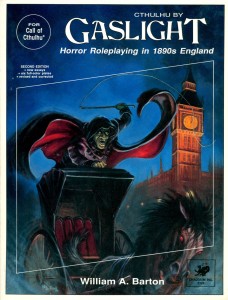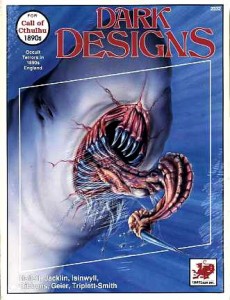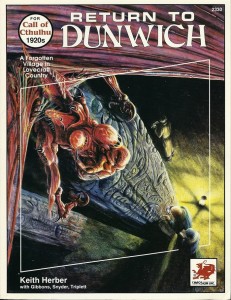By Les Dean and John Tynes, © 1994
[The debut of our review column. I think the review of “Return to Dunwich” set the standard I was looking for in TUO reviews, since it considered the item in question not just as a gaming supplement, but as a creative work with thematic intentions. — John Scott Tynes, 1994]
(Editor’s Note: Yes, another new addition. What better title for an ongoing review column? Submissions to the Eye on anything to do with Lovecraft, CoC, or the Mythos in general are welcome.)
 Cthulhu By Gaslight
Cthulhu By Gaslight
The second edition of CBG has been available for some time. William A. Barton has done an undeniably excellent job with this supplement, as has been shown by the numerous awards it has won. This, of course, is good news to those of us who enjoy adventuring in the 1890s. The historical information, maps, and new occupations for investigators are simply vital to any Keeper hoping to run a campaign set in the Victorian era. Sadly, though, all of this information is supplemented with only one adventure, “The Yorkshire Horrors.” The scenario is good, though unfortunately the investigators must encounter Sherlock Holmes in it. I take a negative view of using Holmes in any adventure because the players are already aware of his strength and experience and could fall into the trap of “He’ll solve it anyway,” or “We’re stumped — let’s call Holmes!” However, the scenario’s use of well-known supporting characters and its easy-to-follow presentation do make it a good adventure for inexperienced Keepers. On a scale of one to ten phobias, with Masks of Nyarlathotep being considered ten phobias, Gaslight rates an eight.
 Dark Designs
Dark Designs
Recently released. The creature on the cover is a Hound of Tindalos, and has my vote for the most repugnant artwork yet done for Chaosium. My congratulations to the artist, Lee Gibbons. Unfortunately, the cover art and the two period maps are the best part of Dark Designs. It includes only three adventures, as well as an 1890’s investigator generation supplement to Gaslight. The first adventure, “Eyes for the Blind,” leads into the third adventure, “Lord of the Dance,” and both go to show that Chaosium pays by the word. These two adventures take up 75% of the book and could certainly have been done in a half to two-thirds of that. There are a few saving graces, however. The main villain in the “Eyes” adventure is excellent, though wise Keepers will give the villain credit for its intelligence and change the noticibly unusual color of the villain’s home. The villain should also have plans to vanish in some way should things go wrong. “Lord of the Dance,” though unoriginal in design, can be made interesting to players with a creative Keeper, and is by far the best of the three adventures in the book. The third, unconnected adventure is “The Menace from Sumatra,” and it shows L.N. Isinwyll’s welcome hand in the editing. The adventure might be made more interesting by adding a simple twist: allow the scenario’s powerful villain to apply the blue fungus from the opening scene to rats. Whether this affects them the same way it does humans or simply allows it to be spread more widely is up to the Keeper’s evil mind.
Dark Designs as it is rates 3 phobias. Good Keepers should be able to squeeze a few more out of it, however.
Other 1890s adventures:
The Vanishing Conjurer / Statue of the Sorcerer: Though the “Statue” half of this Games Workshop book must be set in 1925, “Conjurer” can easily be set in London during the 1890s. Modes of transportation and communication will change, as will the references to Queen Mary and King George (to Queen Victoria and Prince George). The scenario’s unspecific time setting is appreciated, and wouldn’t be a bad thing to see more of.
Fatal Experiments: The “Songs of Fantari” adventure can, with minimal modifications, be adapted to the 1890s, though I do suggest that only NPC’s be subjected to the more fatal of the scenario’s experiments.
Call of Cthulhu 4th Edition: Also with minimal changes, “The Brockford House,” “Paper Chase,” and “The Mystery of Loch Feinn” can all be enjoyable 1890s adventures, already possessing a mood and atmosphere appropriate to the era.
 Return to Dunwich
Return to Dunwich
First and foremost, Dunwich is a fascinating and enjoyable read. The book forms the second in Chaosium’s “Lovecraft Country” series, following Arkham Unveiled, and maintains that book’s standard of quality in writing and thought. It succeeds even moreso than the prior book, in fact. Where Arkham occasionally smacked of being too much a catalogue, Dunwich maintains a constant and rich theme: the price of secrets.
Dunwich Village is just that — a village, much smaller than politely bustling Arkham 45 miles to the east. You’ll find only one real business there, the ubiquitous Osborn’s General Store, housed in an old church. Instead, author Keith Herber has used the space to describe the people and places of the whole area, a region about ten miles wide and fourteen miles long. In addition to this, there is an extensive treatment of — but I really can’t give that away.
Dunwich, you see, is a place full of secrets, secrets that have taken their toll — in more ways than one — on the people of the area. The “secret history” of Dunwich is old and vast, and will come as a stunningly fascinating surprise to even the most knowledgable Keepers and players.
With this in mind, I should state that Dunwich is not a book for inexperienced Keepers or players. Dunwich contains only one scenario, yet the book is truly a campaign, just as much as Masks of Nyarlathotep or Curse of Cthulhu. As the players progress through the adventure, their investigators will continually be running into strange situations and stranger people. Players will soon lose sight of the distinction between the scenario and their more general exploration of the ties that bind Dunwich together. Only experienced Keepers and players should tackle this; by and large, the players will map out the course of the wide-ranging investigation, and the Keeper needs to be familiar enough with all 132 pages (especially the index/directory — a welcome and essential feature) to handle meandering investigations smoothly. If all goes well, though, the experience should be very rewarding.
Keepers needn’t worry about players who have read H.P. Lovecraft’s “The Dunwich Horror,” the primary source for the book. The opening scenario begins a few months after the Horror occurred, with Dr. Armitage of Miskatonic (the story’s nominal hero) hiring the investigators to check into the aftermath of the Horror. Armitage can give the investigators a lot of information, essentially duplicating the benefits that players might gain from reading the story beforehand.
I would advise players or potential players not to look at Dunwich, however. Don’t look at the table of contents, don’t look at the pictures, don’t flip through the pages. Some of the book’s strongest elements would be quicky given away by even a casual glance.
The illustrations, by John T. Snyder, are quite good, some of the best in a Chaosium book in some time. Dunwich does have a number of typographical errors, of the sort that computer spelling checkers don’t catch: plurals instead of singulars, missing words, etc. There are a few other minor annoyances as well. The table of contents has several serious mistakes, some of the “Points of Interest” refer to locations on the maps that aren’t labeled there, and in one case a building is simply missing (#911). While showing the need for further proofreading, Dunwich’s errors are not truly sloppy, a welcome change from the usual low editing standards found in much of the gaming industry and a particular pet peeve of mine.
My chief complaint with Dunwich is the lack of a more detailed guide for Keepers in running it. Dunwich is a fully-fledged campaign, perhaps the most realistic — or at least believable — campaign yet published. As such, it really requires a lot of preparation on the part of the Keeper to run well. A page or two outlining major lines of investigation beyond the scenario, NPC responses and tactics, and likely events and reactions would have been a big help. Much of this information is in the book, but is scattered amongst the dozens of entries.
Return To Dunwich is wonderfully written and is as rich and fertile a campaign supplement as any I’ve seen. Its inappropriateness for less-experienced Keepers and players and its lack of more-cohesive campaign information drag it down slightly, though. Bearing these last two points in mind, Return To Dunwich easily rates seven out of ten phobias. Had more work been done to aid the Keeper in running it, this rating would have been an eight.
